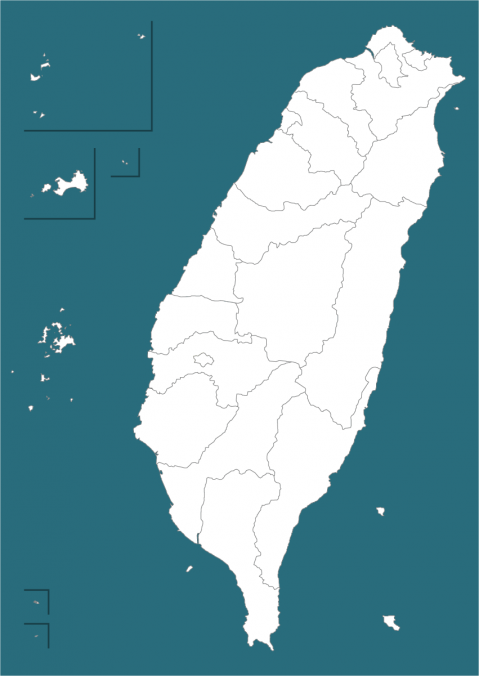
The modern Republic of China is primarily located on Taiwan, or Ilha Formosa, located around 300 kilometres southeast off the coast of mainland China's Fujian Province. Besides Taiwan, the ROC also includes Kinmen (Quemoy), Matsu, the Penghu archipelago (also known as the Pescadores), and various disputed territories in the South China Sea.
By 1949, the Kuomintang (KMT), led by Chiang Kai-shek, was losing support domestically and running out of options. The island of Taiwan, previously a Japanese colony since the Qing Dynasty, was returned to China after the events of World War II, and the KMT decided Taiwan would be the optimal place to regroup, establishing a temporary capital in Taipei, taking with them national treasures, gold, and foreign reserves to prepare and retake the mainland. Estimates range from 1.3 to 2 million mainlander KMT civilian supporters, government officials, and military staff relocated to Taiwan.
As the Chinese Civil War slowly came to a ceasefire, the ROC's influence lessened in mainland China, effectively reducing the ROC's administrative area to Taiwan, Penghu, Kinmen, and Matsu, with the Chinese Communist Party (CCP), led by Mao Zedong, establishing the People's Republic of China (中华人民共和国 or PRC) in mainland China. The PRC views itself as a successor state to the ROC encompassing Taiwan and all Chinese territories, while the ROC views the PRC as an illegal state occupying all of China.
By the ROC constitution, the Republic of China claims all lands currently administered by the ROC and PRC, as well as Mongolia and some territories along mainland China's western borders. In practicality, the ROC only administers the areas within the Taiwan Free Area. The ROC no longer actively pursues reclaiming the mainland as it once did.
At the time of the government relocation, president Chiang Kai-shek enacted martial law, temporarily suspending civil liberties and personal rights in the interest of winning the still-active civil war. After several conflicts across the strait and minor territory changes, Taiwan remained under martial law until 1987, when Chiang's son (and then president) Chiang Ching-kuo, with the support of future president Lee Teng-hui, began liberalising Taiwan's political and economic landscape, resulting in a full democratisation of Taiwan. Chiang Ching-kuo's rule also created many large scale infrastructure projects such as national highways, increased housing, improved telecom, and many other projects in the national interest.
After the appointing of Lee Teng-hui as successor president, Lee worked to fully open the democratic process in Taiwan allowing more voices besides just the KMT, and was continuously elected until 2000. During his tenure, Taiwan began shifting into a localisation movement, where local Taiwanese cultural values and language (previously heavily restricted under martial law) began being promoted alongside and sometimes even over pan-Chinese culture. Other reforms included government streamlining to reflect the reality that the ROC no longer had any power or control over mainland China.
After a corruption scandal, the public voted a Democratic People's Party (DPP) candidate, Chen Shui-bian, as its new president. During his term from 2000-2008, the Taiwan localisation movement continued and flourished, and the administration attempted several reforms trying to create distance between Taiwan and China and to create its own identity, all of which outraged the PRC, bringing cross-strait relations to a new low.
Another corruption scandal resulted in the victory of KMT candidate Ma Ying-jiou elected in 2008. This election was celebrated by the PRC and the two sides began un-officially negotiating various economic and trade agreements, bringing tensions to their lowest level ever. Cross-Strait flights commenced in full, unrestricted service starting in 2009 between Taiwan and mainland China. Previously, travellers had to first transit in a third location such as Hong Kong. Restrictions on entry to Taiwan for mainland Chinese were relaxed considerably, the mainland currency renminbi is now openly traded and exchanged (just as the New Taiwan Dollar is more widely exchangeable in mainland), as well as integration of several banking systems, media production and distribution, and liberalisation of trade tariffs on both sides, just to name a few examples of increased cooperation between the two authorities. President Ma was re-elected in 2012 on the platform of better relations with mainland China, however as of 2014 his approval ratings have plummeted due to various different scandals and concerns, especially from Taiwanese who prefer independence from China and are weary of increased economic interdependence, especially considering the ruling party members' private business relations with the mainland. A meeting between President Ma and PRC President Xi occurred in Singapore in November, 2015, the first meeting between the two parties since the Chiang and Mao era. While both sides referred to each other as "mister" to avoid any political reference and spoke about peace across the strait under the "one China policy" (which in Taiwan is a hotly contested topic), the Taiwanese public is divided over their approval of this action.
In January 2016, the DPP was once again elected by the people, this time to a majority in the Legislative Yuan, as well as Tsai Ing-wen becoming the president. President Tsai and the DPP were re-elected to majorities again in January 2020.
More articles on GuideToTaipei.com about Taiwan's history: